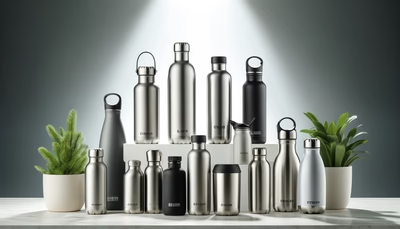Stainless steel water bottles have emerged as a leading choice for those seeking sustainable, durable, and health-conscious alternatives to single-use plastic bottles. Their popularity is driven by a combination of environmental awareness, health benefits, and practical functionality. This comprehensive guide will explore the various facets of stainless steel water bottles, from their production and advantages to their maintenance and market trends.
1. Understanding Stainless Steel Water Bottles
Stainless steel water bottles have become an integral part of the modern eco-friendly lifestyle. These water bottles are not only stylish but also serve as a practical solution to reducing plastic waste. They come in various designs, sizes, and functionalities to cater to different needs, making them suitable for a wide range of activities, from daily commutes to outdoor adventures.
2. Manufacturing Process
Material Selection: The primary material used is food-grade stainless steel, such as 18/8 or 304 stainless steel, known for its resistance to rust and corrosion. This type of stainless steel is safe for food and beverages, ensuring that no harmful chemicals leach into the contents.
Forming the Bottle: The process begins with stainless steel sheets being cut and shaped into cylinders. These cylinders are then welded or pressed into the final bottle shape. For insulated bottles, two layers of stainless steel are used, with a vacuum space between them to provide thermal insulation.
Finishing Touches: After shaping, the bottles are polished to achieve a smooth finish. Some are also treated with a powder coating for added grip and aesthetic appeal. Lids and caps, often made from BPA-free plastic or stainless steel, are designed to fit securely and prevent leaks.
3. Key Benefits
Health Advantages:
- Chemical-Free: Unlike plastic bottles, stainless steel does not contain BPA, phthalates, or other harmful chemicals that can leach into beverages.
- Hygienic: Stainless steel’s non-porous surface resists bacteria and mold, making it easy to clean and maintain.
Durability:
- Long-Lasting: Stainless steel is a robust material that can endure drops, impacts, and rough handling.
- Corrosion Resistant: It withstands exposure to water and other elements without rusting, ensuring a long lifespan.
Thermal Insulation:
- Temperature Retention: Double-wall insulated bottles can keep liquids hot or cold for hours, making them ideal for both hot beverages in winter and cold drinks in summer.
Eco-Friendly:
- Reusable: By using a stainless steel bottle, individuals can significantly cut down on their use of single-use plastics.
- Recyclable: At the end of their life cycle, stainless steel bottles can be recycled, reducing environmental impact.
4. Varieties and Features
Single-Wall vs. Double-Wall:
- Single-Wall: Lightweight and easy to carry, but does not offer insulation.
- Double-Wall Insulated: Heavier but provides superior thermal insulation, keeping drinks hot or cold for extended periods.
Sizes and Capacities:
- Bottles come in a range of sizes, from compact 12-ounce bottles to large 64-ounce growlers, catering to different hydration needs.
Designs and Customization:
- Shapes and Colors: Available in various shapes, from sleek and slim designs to wide-mouth versions for easy filling and cleaning.
- Personalization: Many brands offer customization options, allowing users to choose colors, patterns, and even add personalized engravings.
Additional Features:
- Lids and Caps: Options include screw caps, flip tops, straw lids, and sport tops, providing convenience and suitability for different activities.
- Handles and Clips: Built-in handles and carabiner clips make it easy to carry and attach the bottle to bags or belts.
5. Maintenance and Care
Cleaning:
- Daily Cleaning: Rinse the bottle with warm, soapy water after each use. Use a bottle brush to clean the interior thoroughly.
- Deep Cleaning: Periodically, clean the bottle with a mixture of vinegar and baking soda to remove any stubborn residues or odors.
Preservation:
- Avoiding Damage: Although stainless steel is durable, avoid dropping the bottle or exposing it to extreme temperatures to maintain its appearance and functionality.
- Dishwasher Safety: Check the water bottle manufacturer’s instructions. While many stainless steel bottles are dishwasher safe, hand washing is often recommended to preserve the finish and insulation properties.
6. Leading Brands and Innovations
Several brands have established themselves as leaders in the stainless steel water bottle market:
- Hydro Flask: Known for their high-quality insulated bottles that keep beverages hot or cold for hours.
- Klean Kanteen: Pioneers in the industry, offering a wide range of sustainable and versatile bottles.
- S’well: Renowned for their stylish designs and excellent temperature retention capabilities.
Recent innovations in the market include collapsible stainless steel bottles, integrated filtration systems, and smart bottles that track hydration levels and remind users to drink water.
7. Conclusion
Stainless steel water bottles represent a perfect blend of sustainability, health benefits, and practicality. By choosing stainless steel over single-use plastics, consumers can make a significant positive impact on the environment while enjoying the advantages of a durable, safe, and versatile hydration solution. With a wide range of options available, from basic designs to feature-rich models, there is a stainless steel water bottle to meet every need and preference.



